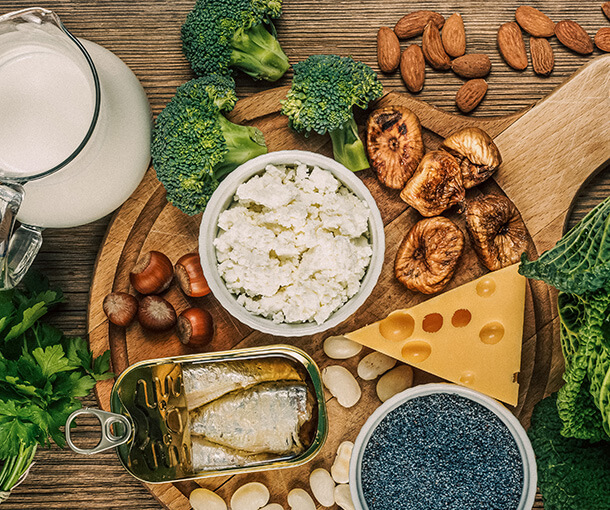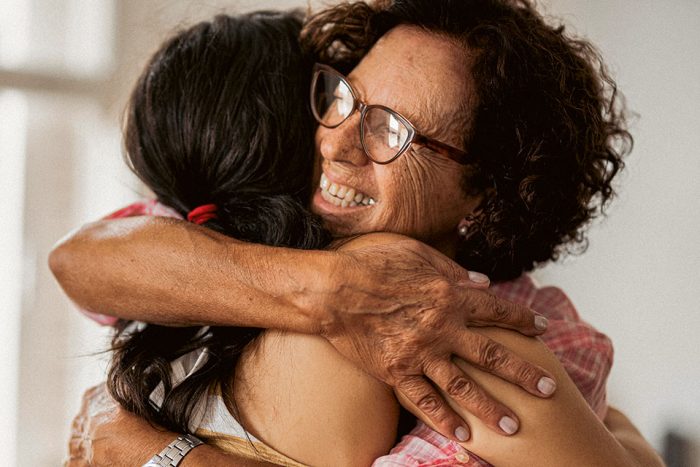Your body needs calcium to build strong bones and healthy teeth.1,2 Find out where to get your calcium, and how much calcium you need every day to keep your bones strong and healthy.
3 things you need to know about calcium
- Dairy foods are typically the richest source of calcium in our diets, but other foods can also be a source of calcium.2,3
- Getting enough calcium is important throughout life, but it’s especially important during childhood & adolescence and as you get older.2
- Your body needs vitamin D to absorb calcium from your food2.
What is calcium?
Calcium is the main building block for healthy bones and teeth. Your body can’t make the mineral calcium, so it must come from the food you eat. 1,2
Why is calcium important?
- Nearly all (99%) of the calcium in your body is found in your bones and teeth; calcium is essential to build bones and keep them strong.1,2
- Bones constantly renew themselves to stay strong and healthy; old bone is removed and replaced with new bone3, this process requires calcium as well as other minerals.
- It’s important to consider your calcium intake for bone health at every stage of life, to optimize this constant renewal process.
- If you do not get enough calcium, your body cannot build strong bones. And if your intake is constantly too low, it can leave your bones weak and brittle and even lead to osteoporosis in later life.
How much calcium do I need?
- It’s important to get enough calcium throughout your life, as your bones constantly renew themselves to stay strong and healthy.
- Be sure to get enough vitamin D. Without enough vitamin D, your body cannot absorb the calcium from the food you eat2. Further information about the role of vitamin D in bone health is available from the Vitamin D factsheet.
Changing requirement for calcium over a lifetime
The amount of calcium you need changes over your lifetime. Children, adolescents and older people need the most calcium.1,2,3 Check below to read more about calcium over a lifetime.
Calcium & pregnancy & infancy
- A developing baby needs calcium, especially during the third trimester of pregnancy when the skeleton is developing (80% of the total calcium needed by a developing baby is acquired from the mother during the third trimester of her pregnancy).
- Pregnant women absorb calcium more effectively than usual, which supplies their baby’s extra requirements.1,3,4
- A newborn baby’s bones contain about 30 g of calcium!4
- A newborn baby’s bones continue to develop after birth, doubling in mass over the first year4. Breastmilk is a good source of calcium and supports this rapid growth and strengthening of the bone.
Calcium & children/adolescents
- Children’s skeletons are constantly growing, so children need plenty of calcium.3
- Calcium is especially important during adolescence, when puberty prompts a growth spurt and bones reach their maximum rate of growth. The stronger a teenager’s bones are at this time, the greater their likelihood of keeping strong healthy bones as they age2,3. This is the time where we need the most calcium in our diet. Think of it like building a ‘bone bank’ for later in life.
Calcium intake during adolescence can help shape a person’s bone health for the rest of their life
Calcium & adulthood
- It is important to consider bone health in adulthood too, to complete the building of a ‘bone bank’ and also to maintain our bone mass into older age.
- We reach our peak/maximum bone mass in our 30s. The more we have in our ‘bone bank’ at this stage, the more we have in reserve for later in life, to stave off the age related decline in bone density.
- We must maintain our ‘bone bank’ once we reach peak/maximum bone mass, by consuming enough calcium and other minerals to support the constant remodelling of our bones.
Calcium & menopause
- Hormonal changes at menopause mean women lose bone density quickly at this time. (The bone renewal process becomes unbalanced – more bone is lost than is replaced.)11
- Between the ages of about 50 and 70 years, women need more calcium than men to make up for this rapid bone loss.1
- The changes in hormones during menopause are why osteoporosis is more common in Australian women, although men do still account for around 30% of osteoporosis cases in Australia.10
Calcium & seniors
- Absorption of calcium by the gut becomes less efficient as we age, so we need to consume more calcium as we get older.2,3
- Bones lose density and become weaker as we get older. This process starts at menopause for women, and some years later (around age 70 years) for men. So we need more calcium than younger adults to maintain bone health.2,3
Which foods are rich in calcium?
Calcium and dairy food
- Dairy foods such as milk, yoghurt and cheese are excellent sources of calcium in the diet.2,3
- Depending on your age and gender, about 2 to 4 serves of dairy food per day gives you enough calcium.
“ Over half of Australians, 2 years and older, do not meet the requirements for calcium intake through diet alone. The prevalence of insufficient calcium intake is higher in women (73%) than in men (51%).”11
Vegan, lactose intolerant or simply don’t like dairy?
- Some non-dairy foods are rich in calcium one serve of tinned sardines or salmon (with bones) contains about as much calcium as one serve of dairy.6,3
- Look for foods fortified with calcium, such as juice, soy products such as tofu and soy milk, breakfast cereals and bread.3
- Other non-dairy foods contain less calcium, and the calcium they do contain is not absorbed from the gut as easily as calcium from dairy foods. These sources of calcium include3:
- leafy green vegetables – broccoli, kale, collards (cabbage family), bok choy, Chinese cabbage and spinach
- nuts and seeds – brazil nuts, almonds and sesame seed paste (tahini).
‘Want to find out if you’re getting enough calcium from your diet? Use our Calcium Calculator’
Can I get enough calcium from my diet?
- Australian dietary guidelines recommend you get most calcium from your diet. However, most Australian children (up to 9 in 10 adolescent girls and 7 in 10 adolescent boys) and about half of all Australian adults do not eat enough calcium-rich dairy food.11 Tips for increasing dairy in your diet2:
- Add milk or skim milk powder to soups or casseroles
- Add a yoghurt topping to soups, salads, or cereals
- Sprinkle grated hard cheese over potato, pasta and rice dishes
- Your body needs vitamin D to absorb calcium from food. If you do not get enough vitamin D, you may not be absorbing all the calcium2 you consume.
- Many other factors can affect the amount of calcium in your bones3
- smoking
- high salt diet
- high alcohol intake
- high caffeine intake (e.g. 6 cups of coffee, tea or cola)
- high intake of phytates (from seeds, nuts, grains) and oxalates (from plants such as spinach, rhubarb, beans
- low levels of physical activity
- Calcium supplements can help top up levels if you do not get enough calcium from your diet. Talk to your pharmacist or doctor about your calcium requirements.
3 interesting facts about calcium
- Less than half of all Australian adults actually get their daily recommended intake of calcium through diet alone.2
- An average human body contains roughly 1–1.5 kg of calcium.9,2
- Bones and teeth appear white on X-rays because they contain calcium (calcium blocks X-rays, leaving a white area on the X-ray film)
Disclaimer: This article is meant for information purposes only. Please consult your health professional if you have further concerns or questions related to your nutritional requirements for calcium.
References available on request.
MAT-AU-2401874
References
1. National Health and Medical Research Council and New Zealand Ministry of Health. Nutrient reference values for Australia and New
Zealand. 2006.
2. Healthy Bones Australia. What you need to know about osteoporosis. Consumer guide. 4th Edition 2017.
3. Victoria State Government Better Health Channel. Calcium. Available from
https://www.betterhealth.vic.gov.au/health/HealthyLiving/calcium. Accessed April 2019/
4. Kovacs CS. Maternal mineral and bone metabolism during pregnancy, lactation and post weaning recovery. Physiol Rev 2016; 96:
449–547.
5. Australian Government National Health and Medical Research Council (2013) Australian Dietary Guidelines. Canberra: National Health
and Medical Research Council.
6. International Osteoporosis Foundation. Calcium content of common foods. Available from
https://www.iofbonehealth.org/osteoporosis-musculoskeletal-disorders/osteoporosis/prevention/calcium/calcium-content-commonfoods.
Accessed September 2019.
7. Dairy Australia. Dairy food myths. Available from www.legendairy.com.au. Accessed April 2019.
8. CSIRO. 2007 Australian National Children’s nutrition and physical activity survey.
9. Mitchell HH et al. The chemical composition of the adult human body and its bearing on the biochemistry of growth. J Biol Chem 1945;
158: 625–637.
10. Healthy Bones Australia. Osteoporosis costing all Australians: A new burden of disease analysis – 2012 to 2022. Available from
https://www.osteoporosis.org.au/sites/default/files/files/BofD_Exec_Sum_for_print.pdf (accessed Nov 2019)
11. Australian Bureau of Statistics. Australian Health Survey: Usual Nutrient Intakes, 2011 12. Cat. No. 4364.0.055.008
12. Source: Mitchell P.J. et al. Life-course approach to nutrition. Osteoporosis international. 2015; 26:2723-42.







